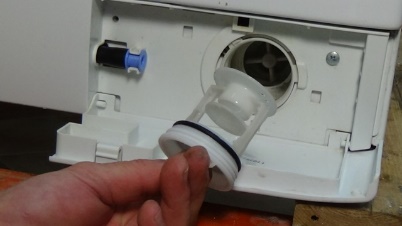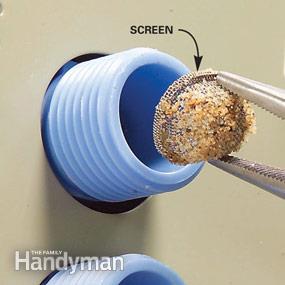Introduction
The instruction provided describes the cleaning process of the filter at the washing machine. The design of automatic washing machines includes such elements as filters: drain and inlet, which protect equipment from pollution and breakdowns. Cleaning the drain or inlet filter is one of the defensive operations that should be carried out periodically. The process represented can be carried out both in a professional workshop and at home, and the paper presented is explicitly aimed at an unprofessional audience, that is, at average users.
In recent years, the number of applications of washing and drying machines has increased; the written guidance can be accessible among broad layers of users of the equipment. Firstly, home cleaning of the filter increases its service life and improves the productivity of the machine itself. Secondly, the amount of microplastic in the water rises every day, and filters need more frequent cleaning, which in workshops can be considerably expensive (Hoang, p. 26). Thirdly, rinsing the filter prevents many types of breakdowns in washing machines and thereby prevents repairs and waste by the consumer.
Drain Filter Cleaning
Wastewater is cleaned of various debris (coins, buttons) using a drain filter. The filter element may become clogged by the presence of impurities and heavy items in the water. Cleaning is necessary to prevent small organic and inorganic pollutants from entering the pump (draining and pumping out the dirty waste liquid after washing or excess water after rinsing) and nozzles (used to connect drains), which can damage parts. Signs indicating the need for the procedure are:
- the termination of all functions;
- difficulties in draining the liquid, during which it slows down or completely stops;
- the system instantly turns off after switching to spin mode;
- the rinse function is not performed.
Each of these marks is a signal to take steps to free the filter from debris. Before removing the filter, it is necessary to stock up on a container for draining water and dry rags, covering them with a machine and slipping them under the bottom. The fact is that even after discharge, a certain amount of water remains in it. Rags absorb liquid and protect the floor from moisture. It will be necessary to shut off the water and disconnect the machine from the electrical network to ensure safety, and then water should be drained from the tank of the washing machine. The process presented is done because, in some models, there are nodes that are not able to disconnect from the power supply instantly. After the user makes sure that the machine is completely turned off, they can begin to work. The filter cover should be unscrewed and pulled out of the socket before removing it.

After that, the following manipulations are carried out:
- Rinsing under running water;
- Brushing contaminated areas;
- Purification of limescale and elimination of unpleasant odors by soaking in a solution of citric acid and water;
The filter nest in the machine is also cleaned, as debris can get stuck in it. To make the procedure more comfortable, use a flashlight to illuminate dark areas. After removing debris and rinsing under running water, the clean part is replaced.
Inlet Filter Cleaning
In washing machines, there is also an inlet filter element in the form of a mesh that does not allow foreign objects and impurities to pass through. Such devices are not provided in all models of machines.

Signs of clogging in the inlet filter are:
- reduced pressure of water entering the machine;
- increased washing time;
- the device works well, but when filling, it buzzes and does not fill with liquid.
The element is connected to the inlet hose and is located near the water supply valve. The water supply system filter is positioned at the top of the machine; to access it, the user needs to unscrew the water supply hose. To correct the difficulty, the consumer will need to clean the inlet filter. The represented fixing is done in the following sequence:
- Shut off the water before cleaning;
- The filler tube is removed, after which the filter mesh will be visible;
- The grid is removed using pliers, which must be done carefully, as it is very fragile and can break;
- The recovered element is cleaned and washed with water;
- The clean filter is returned, and the hose is attached back to its place.
Types of Pollution and The Factors That Cause Them
Before cleaning the filters, it is necessary to determine the type of contamination and the reasons for their appearance. There are defensive methods and tools to prevent the formation of clogs. Knowing the causes, consequences, and ways to resolve the problem, the consumer will extend the operational life of their machine and ensure its smooth operation. In addition to ordinary garbage falling into the washing machine along with things, average dirt, limescale, scale, and mold deposits can be considered as filter contaminants. There are different ways, and improvised means to eliminate them. With their help, people not only clean the filters but also prevent the appearance of contaminants. The causes of filter pollution are:
- hard water;
- particles, villi, separated from the clothes being washed (Schöpel, p. 94);
- untimely cleaning and drying of all elements of the machine;
- inferior quality washing powders and other detergents.
Poor quality water is becoming one of the main reasons for the formation of scale and limescale on filters and other parts of machines. Professional and homemade products can be used to clean the washing machine, and as improvised cleaners can be applied, acetic or citric acid, soda. These are excellent cleaning products for every homemaker. Professional tools are selected following the functional features of the device and one’s financial capabilities. Cleaning can also be done mechanically, but not independently, but with the help of specialists who use specialized tools for these purposes. If dirt, lint from clothing gets on the filter, as well as when cleaning and using poor-quality detergents promptly, deposits of dust, mold, and an unpleasant odor are formed. Cleaning is carried out, as in the first case, by home and professional means. After cleaning and rinsing, all parts must be wiped with a clean piece of cloth and dried.
Conclusion
Summing up, it can be stated that the operational life of an automatic washing machine depends on proper care. Cleaning can be done at home conditions, which saves the user’s money and time. The process described should be carried out at least twice a year. It is easy to figure out how and with what kind of chemicals to clean the filters. The user should only determine the type of contamination and, under it, choose the type of product that will help them remove it. Moreover, to prevent this type of repair, several measures can be taken, such as installing a filter that will purify the water entering the machine.
Works Cited
- Hoang, Hiep Nguyen. “Washing Machine Microplastics.” Tampere University of Applied Sciences, 2019, pp. 24–29. Web.
- Schöpel, Bettina, and Rainer Stamminger. “A Comprehensive Literature Study on Microfibers from Washing Machines.” Tenside Surfactants Detergents, vol. 56, no. 2, 2019, pp. 94–104.
- The Family Handyman. “How to Clean a Washing Machine Inlet Screen.” The Family Handyman, 2018. Web.
- “How to Clean Your Washing Machine in 9 Easy Steps | Domex Ltd.” Domex, 2019.